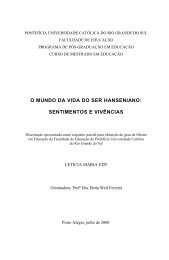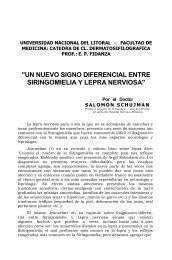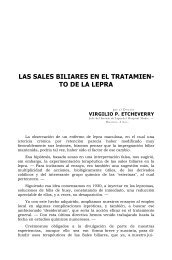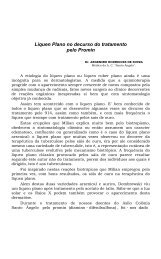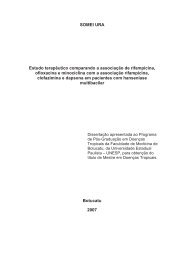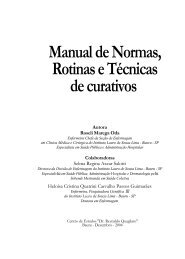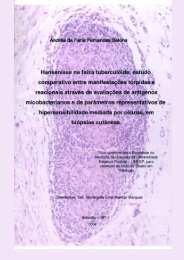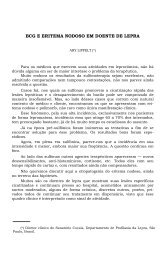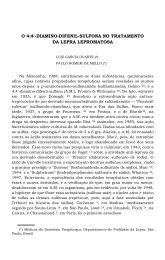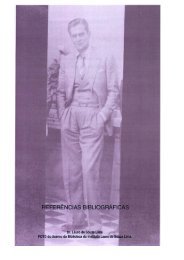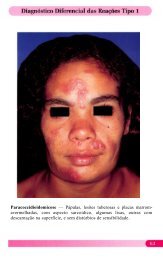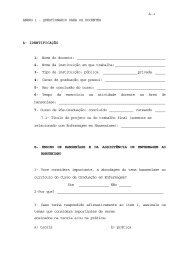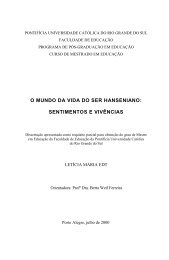INTERNATIONAL JOURNAL OF LEPROSY - Index of
INTERNATIONAL JOURNAL OF LEPROSY - Index of
INTERNATIONAL JOURNAL OF LEPROSY - Index of
You also want an ePaper? Increase the reach of your titles
YUMPU automatically turns print PDFs into web optimized ePapers that Google loves.
INTERNAI IONAI. _h/URNA]. <strong>OF</strong> <strong>LEPROSY</strong> ^<br />
<strong>INTERNATIONAL</strong><br />
<strong>JOURNAL</strong> <strong>OF</strong> <strong>LEPROSY</strong><br />
and Other f.9ycobac[erial Diseases<br />
VOLUME 69, NUMBER 1<br />
Viable M. leprae as a Research Reagente<br />
Richard W. Truman and James L. Krahenbuhl 2<br />
The viability <strong>of</strong> hacterial preparations<br />
can have a marked influence on experimental<br />
results. Replication and growth <strong>of</strong> bacilli<br />
has always been considered the g old standard<br />
for hacterial viability. Unfortunately,<br />
Mvrobarteriunl Icprc u' replicate only in living<br />
tissues, and the levei <strong>of</strong> growth<br />
achieved by organisms inoubated into<br />
mouse foot pads (MFP) has been the only<br />
means to quantify viability <strong>of</strong> M. leprae.<br />
Such procedures require a high levei <strong>of</strong><br />
technical expertise and can yield results<br />
only several months after the bacilli already<br />
have been used in experiments. As a conse-<br />
(vence, very few laboratories quantify M.<br />
leprae viability.<br />
In recent ideies, a nulllher <strong>of</strong> I11 l'i/lo biochemical<br />
assays have been employed as<br />
screening aids for anti-M. leprae drur developmcnt.<br />
These assays do not nleasure<br />
replication <strong>of</strong> M. leprae in litro but index<br />
their ATP contem or uptake <strong>of</strong> radiolabeled<br />
carbon sources in axenic media. Since<br />
maintenance <strong>of</strong> metabolic activity is a halluark<br />
<strong>of</strong> viability, detecting changes in the<br />
' Rcceived for puhlication on 4 October 2000. Acccpted<br />
for publication in revise(' Iìrrm 00 17 January<br />
2001.<br />
2 R. W. Truman. I'h.I).; J. I.. Krahenhuhl. I'h.l)..<br />
Lahoratorv Research Branch, Il: uisen's I)isease Progranis<br />
at LSU -SVM. Y.O. Box 25072. Baton Rouge,<br />
Louisiana 70894. U.S.A.<br />
Rcprint requcsts to Dr. ]'rumam a( the above address<br />
or FAX 1-225-578-9856; e-mail:<br />
rirtimal@Isti.edu<br />
\'olume 69. Number 1<br />
l'rAned in the USA.<br />
(ISSN 0145-916X)<br />
MARCH 2001<br />
metabolic status <strong>of</strong> hacteria incubated in the<br />
presence <strong>of</strong> candidate drugs suggests a loss<br />
in viability and presumptive efticacy for the<br />
drug.<br />
Our laboratory already has shown that<br />
oxidation <strong>of</strong>' 1C-palmitate by M. /eprac in<br />
axenic culture is useful for drug screening.<br />
The technique detects changes in the metabolic<br />
activity <strong>of</strong> M. leprae manifest by<br />
drugs both in vivo and in vitro, and the assay<br />
has good qualitative association with<br />
MFP results (').<br />
In this study, we examined the utility <strong>of</strong><br />
palmitate oxidation for detecting quantitative<br />
differences in the viability <strong>of</strong> M. leprae<br />
111 conipariSO11 to conventional 111011SC foot<br />
pad nlcthods. We also used the technique to<br />
describe the effect that many con unon laboratory<br />
procedures have on M. lc'pi'ae viability<br />
in order to help liighlight appropriate<br />
handling practices for viable M. leprci e and<br />
to increase our understanding <strong>of</strong> this resource<br />
as a research reagent.<br />
MATERIALS AND METHODS<br />
Leprosy bacilli<br />
Nude mouse-derived bacilli. Mvcobactc'rium<br />
leprae (isolate T-53) was maintained<br />
in serial passage in the foot paris <strong>of</strong> athymic<br />
BAL13/c nu/nu mele nlice (Harlan, Incllanapolis.<br />
Indiana. U.S.A.). Mice were inoculated<br />
on the plantar surface <strong>of</strong> both hind<br />
feet and harvested when their foot paris<br />
were nloderately enlarged (0.5 g-1 g). and<br />
contained numerous rapidly growing bacilli.
2^ International .1()Itrmil <strong>of</strong> Lepro.vy^ 2001<br />
We harvested the bacilli using a procedure<br />
describcd previously 1). Generally, the<br />
boi pais were cleansed in Betaline" and<br />
the skin remove(' belOre the highly bacilliferous<br />
tissue was excised and manually<br />
homogenized ( Wheaton Science Products,<br />
Millville, New Jersey, U.S.A.) in 10 ml <strong>of</strong><br />
7111 2 medium. Excess tissue was remove('<br />
by slow-speed centrifugation, and the<br />
bacillary suspension was enumerated by<br />
direta count before aliquoting for further<br />
study according to a procedure described<br />
earlier (15.'").<br />
A rmaddlo-derived 114. leprac. We made<br />
some AI. /eprae suspensions from the tissues<br />
<strong>of</strong> nine-banded annadillos. These animais<br />
were experimentally inoculated Miravenously<br />
with 1 x 10" mi ude mouse-derived<br />
leprosy bacilli and had incubated the infection<br />
for between 14 to 30 months belOre being<br />
harvested in the very latest stages <strong>of</strong><br />
fullv disseminated leprosy. Bacterial suspensions<br />
derived from armadillos were p•epareci<br />
as fresh tissue homogenates <strong>of</strong> highly<br />
bacilliferous li ver, spleen, lymph node or<br />
leproma in a manner analogous to the procedure<br />
use(' tOr nude tamise foot pads described<br />
above. Ali <strong>of</strong> the armadillo iissues<br />
contained greater than 1 x 10`) M. leprae per<br />
grama. The tissues WCW taken ai varying<br />
times over a 3-year period and ali were free<br />
<strong>of</strong> cultivable contaminants.<br />
Radiorespirometry (RR)<br />
We assesseel the ability <strong>of</strong> each 114. /eprae<br />
suspension to oxidize '4C-palmitate in<br />
BACTEC 7111213 meelitim (i3ecton i)ickinson<br />
Inc., Franklin Lakes, New Jersey,<br />
U.S.A.). Suspensions <strong>of</strong> M. leprae were<br />
incubated iii commercially prepared BAC-<br />
TEC vials containing 4 mal <strong>of</strong> the medium,<br />
or in closed-cap Buddemeyer-type culture<br />
vessels containiqz 1 ml <strong>of</strong> the same commercially<br />
prepared BACTEC medium. Oxidation<br />
o{ palmitate by M. leprae resulte(' in<br />
the release <strong>of</strong> radiolabeled CO,. The<br />
evolved gas was detected either dire-étly. in<br />
the case <strong>of</strong> BACTEC vials, vali a<br />
BACTEC 460 instrument or inehrectly, in<br />
the case <strong>of</strong> Buelclemeyer vessels, ou a Beckman<br />
LS6000ic (I3eckman Counter, Inc.,<br />
Fullerton, U.S.A.) scintillation<br />
counter with the aid <strong>of</strong> absorbent strips saturated<br />
with sodiumn hydroxide and scintilla-<br />
tion lluid Inside each 13udelemeyer vessel<br />
(1). For BACTEC vials, an average growth<br />
index (G 1) for each suspension was determine('<br />
on triplicate vials inoculated with 1 x<br />
bacilli afiem- they had incubated for 7<br />
days ai 33°C. The mean G1 was convencei<br />
to DPM/10" hac iii 1 using the manufacturer's<br />
formula accompanying each media<br />
lot. The activity in Budelemeyer vessels was<br />
real directly 7 days after those cultures hal<br />
incubated at 33°C. For comparative purposes.<br />
the mean DPM/10" bacilli were derived<br />
from tripheate sets.<br />
Mouse foot pad studies<br />
The levei <strong>of</strong> growth that each M. leprae<br />
suspension achieved in conventional mouse<br />
foot pads was considered the standard for<br />
viabilitv. The MFP technique was performe('<br />
according to the method descri bed<br />
by Shepard with maior modilications<br />
In brief, 30 til aliquots <strong>of</strong> bacillary suspensions<br />
containinu 1 x 1 0 114. /epme diluted<br />
in Hanks balanced salt solution (1-1 13S5;<br />
Gibco, Grand island, New York, U.S.A.)<br />
\vere inoculated into both hind foot pads <strong>of</strong><br />
conventional BALB/c micc (1 1 arlan ). The<br />
foot pads were harvested ah 90. 120, or 150<br />
days post-inoculation in ()reler to assess the<br />
levei <strong>of</strong> growth achieved by the bacillary<br />
suspensions. In experiments wherc mice<br />
were harvested at multiple time intervals,<br />
control samples <strong>of</strong> freshly harvested 114. leprae<br />
diluted to concentrations <strong>of</strong> 1 x 104, 1 x<br />
103 and 1 x 102 baeilli in 30 1.11 HBSS also<br />
were inoculated into ~ase foot pads.<br />
These diluted control samples were used to<br />
simulate the growth that might be expected<br />
after a —90% and —99% effective loss <strong>of</strong> viability<br />
in those individual preparations (").<br />
For enumeration <strong>of</strong> MFP growth, four mice<br />
were harvested in each group with comas<br />
meie on paired samples and the observations<br />
averaged.<br />
Storage and handling conditions<br />
We compared the ability <strong>of</strong> several<br />
leprae suspensions to maintain viability<br />
during, storage. After harvesting M. leprae<br />
from nide mouse foot pads, bacilli were<br />
aliquoted to 20 ml closed-cap serum vials<br />
(Wheaton) containinu 4 ml <strong>of</strong> Middlebrook<br />
7111 2 at a concentration <strong>of</strong> 1 x 10' M.<br />
roelmiii Immediately after dispensing the
69. I^irumun um/ Krahenhulil: M. leprae Viability^3<br />
U<br />
(o<br />
m<br />
o<br />
2<br />
C<br />
a)<br />
E<br />
CD<br />
CO<br />
70000 ^<br />
60000 -<br />
50000 -<br />
40000 -<br />
30000 -<br />
20000 -<br />
10000 -<br />
0<br />
v o<br />
-<br />
0<br />
•<br />
0<br />
Each Symbol a Different Harvest<br />
Data Pairs at 7 & 21 Days<br />
Fresh^-80^4^25^33^37<br />
Storage Temperature °C<br />
Fui. 1. Scattcrgrams depieling the radiorespirumetric activity <strong>of</strong> different M. leprue suspensions (N = 10) uhun<br />
inicial harvest liunt nude muuse foot pads (fresh) and after storage in 71112 liquid ntedium at temperatures ranging<br />
from 0°C to 37°C. Each harvest is represented hy its own symhol. Paired scatters at each temperature demonsunate<br />
the activity <strong>of</strong> that preparation with storage for 7 days and 21 days, respectively. Figure shows that M. lcprue<br />
xary in activity with each harvest and viability wanes with storage.<br />
bacilli to storage vials, aliquots <strong>of</strong> the sample<br />
were removed to determine its original<br />
baseline activity using RR and MFP. Afterward,<br />
the vials were held at —80°C, 4°C,<br />
25°C, 33°C, and 37°C for up to 3 weeks.<br />
Additional aliquots <strong>of</strong> identical amounts <strong>of</strong><br />
bacilli were removed again at 7- and 21 -day<br />
intervals to retest the samples for changes<br />
in viability during storage. The RR and<br />
MFP results derived from individual stored<br />
samples were compared to the baseline results<br />
originally obtained with each fresh<br />
suspension and expressed as a percent <strong>of</strong><br />
the original activity. Some RR and MFP results<br />
also were correlated directly in a linear<br />
regression model to discern the association<br />
<strong>of</strong> palmitate oxidation with MFP growth.<br />
All statistical comparisons were made on a<br />
personal computer using the SAS pr <strong>of</strong>iram<br />
package (Statistical Analysis Systems,<br />
Cary, North Carolina, U.S.A.).<br />
RESULTS<br />
1\laintenance <strong>of</strong> metabolic activity<br />
with storage<br />
Suspensions <strong>of</strong> M. leprae prepared from<br />
different nude mouse foot pads are not uniform<br />
in their ability to oxidize ' 4C-palmitate,<br />
but exhibit a broad range <strong>of</strong> detectable<br />
metabolic activities. The original activity<br />
tends to wane over time. We used 10 different<br />
suspensions to examine the ability <strong>of</strong> M.<br />
Icprae to maintain their metabolic activity<br />
when stored for periods <strong>of</strong> 1 to 3 weeks in<br />
7H12 liquid medium at temperatures ranging<br />
from —80°C to 37°C. As shown in Figure<br />
1, the oxidative metabolism <strong>of</strong> palmi-
4 ^ International Journal <strong>of</strong>. Leptvsy ^ 2001<br />
90 ^ 120 ^ 150<br />
• Fresh Control<br />
Fresh Control<br />
Fresh Control<br />
-111V- 40 1 Week<br />
- O- 40 2 Weeks<br />
-0- 40 3 Weeks<br />
Days Post Infection<br />
—À— 330 1 Week<br />
—iek— 330 2 Weeks<br />
-4- 330 3 Weeks<br />
•• -800 1 Week<br />
•• -800 2 Weeks<br />
• .• -800 3 Weeks<br />
FIG. 2. Average percent <strong>of</strong> growth in conventional mouse foot pads at various time intervals achieved by M.<br />
leprae suspensions (N = 3) stored in 711121i1uid inedium ai 4°C and 33°C for 7, 14 and 21 clays as compared<br />
to the baseline growth achieved by the same fresh bacillary suspensions prior to storage. Fresh control saiupies<br />
were inoculated ai 0111 streiwth (104/foot pad) and ai concentrations simulating a -90% and -99% effective<br />
loss in viability (107foot pad and 102/foot pad, respectively). Stored samples failed to grow to the same leveis as<br />
full strength fresh samples.<br />
tate declined markedly in each sample over<br />
the 3 weeks <strong>of</strong> storage as compared to the<br />
activity originally detected in the fresh suspension.<br />
Regardless <strong>of</strong> the storage conditions<br />
used, most samples retained
69, 1^Truman and Krahenbuld: M. leprae Viability^5<br />
and 6()% <strong>of</strong> their overall activity in 3<br />
weeks. Suspensions held at 25°C showed a<br />
similar panem <strong>of</strong> decline. The percent <strong>of</strong><br />
loss tended to be greatest among suspensions<br />
whose fresh samples hal the highest<br />
original baseline activities.<br />
It is especially noteworthy that in each <strong>of</strong><br />
the replicate experiments, Al. leprae suspensions<br />
held ai 37°C, or subjected to<br />
freeze-thaw cycles, showed very rapiel loss<br />
<strong>of</strong> metabolic activity. Virtually ali <strong>of</strong> the detectable<br />
activity toward palmitate was lost<br />
within only a few days when M. leprae cultures<br />
were incubated at 37°C. Bacillary suspensions<br />
held at —80°C and thawed once<br />
also registered only 1%-5% <strong>of</strong> the metabobe<br />
activity detected in their fresh suspensions.<br />
Repeated freeze-thaw cycles eliminated<br />
virtually ali <strong>of</strong> their detectable oxidative<br />
activity. In addition, retaining the<br />
bacilli in whole tissues during freezing did<br />
little to preserve their metabolic activity.<br />
Bacillary suspensions prepared from four<br />
different 0.5-g nude mouse tissue samples<br />
frozen to —80°C for 24 hr retained an average<br />
<strong>of</strong> only 7% ± 3.6% <strong>of</strong> the oxidative activity<br />
exhibited by bacillary suspensions<br />
prepared from portions <strong>of</strong> the same tissues<br />
before freezing.<br />
Loss <strong>of</strong> infectivity with time<br />
and temperature<br />
We also examined the infiuence <strong>of</strong> storage<br />
on M. leprae viability as determined<br />
with the conventional MFP technique.<br />
Bacillary suspensions derived from three<br />
different nude mice were held from O to 3<br />
weeks at —80°C, 4°C and 33°C before aliquots<br />
were removed and tested for viability.<br />
As shown in Figure 2, stored suspensions<br />
lost viability quickly and failed to<br />
grow in the mouse foot pads to the same<br />
leveis as the full-strength, fresh control<br />
samples.<br />
In comparing the levet <strong>of</strong> growth<br />
achieved by stored suspensions to control<br />
samples at various time points, we can estimate<br />
the relative loss in viability incurred<br />
during storage. Bacillary suspensions held<br />
in storage at either 4°C or 33°C for up to 2<br />
weeks grew in MFP to leveis generally<br />
comparable to fresh suspensions which<br />
contained only 10% <strong>of</strong> the number <strong>of</strong> viable<br />
bacilli. Samples which had been frozen to<br />
—80°C and thawed even once or repeated<br />
times showed either no detectable growth in<br />
MFP ai ali or grew to leveis comparable to<br />
fresh bacillary suspension controls which<br />
contained only
6^ IruernatioI nrl Journcrl n/ Lc'hrosv ^ 2001<br />
O<br />
100 -<br />
X<br />
a co<br />
a- }, 10 -o<br />
o<br />
LL<br />
o<br />
co<br />
m<br />
o<br />
J<br />
1<br />
0.1<br />
100 ^ 1000 ^ 10000 ^ 100000<br />
Log DPM 7 Day Culture<br />
Bacillary Number vs. Buddemeyer DPM<br />
— Piot linear regression line for correlation<br />
- — Plot 95% confidente limits<br />
Fic. 3. Linear regression andei comparing radiorespirometric activity <strong>of</strong> Al. teproe suspensions (N = 47)<br />
with conventional MFP growth residis obtaincd for each suspension at 120 days postinfection in the mouse (r =<br />
0.71). The data in each axis are Iou transforined.<br />
average activity for bacilli from armadillo<br />
1epron ut was not signilicantly different<br />
from the other armadillo tissues. However,<br />
lcproma-derived bacilli also showed the<br />
treatest variability in oxidative activity <strong>of</strong><br />
ali the types <strong>of</strong> tissues tested.<br />
The oxidative activity ohserved amove<br />
nude mouse-derived bacilli was signilicantly<br />
higher than that from armadillos.<br />
However, it too showed considerable variability.<br />
The nude mouse foot paris we barvested<br />
were mostly <strong>of</strong> medium size, averaging<br />
0.82 g, bui data was availahle on foot<br />
pads ranging in size from 4.1 g to 0.1 g. We<br />
compareci the RR results from these different<br />
harvests with the duration <strong>of</strong> each infection<br />
in the mouse and its bacillary yield. As<br />
shown in Figure 5, the highest metabolic<br />
activities were associated with shortcr intervals<br />
<strong>of</strong> infection that yielded low-to-nwderate<br />
numbers <strong>of</strong>M. leprae. Bacilh from very<br />
large, especially ulcerated foot paris,<br />
showed the lowest overall activity. The<br />
three-dimensional bit ure depicts the association<br />
<strong>of</strong> increasing time and bacillary number<br />
with declining radiorespirometric activity.<br />
No data were availahle for infections <strong>of</strong><br />
less than 140 days' duration, and the relationship<br />
<strong>of</strong> metaholic activity or viahility<br />
with very short-term infections in nude<br />
mice is not described. However, with increasing<br />
duration <strong>of</strong> infection ou bacterial<br />
nutnhcr the viahility <strong>of</strong> M. /cprae obtaincd<br />
from nude mouse foot pads declines.
69, I^Manar] and Krahenbuld: M. leprae Viability ^ 7<br />
40000<br />
35000<br />
ci.) 30000<br />
(1) 25000<br />
mo 20000<br />
a_ 15000<br />
O<br />
10000<br />
5000<br />
O<br />
Mean (SD) from palmitate<br />
oxidation in axenic medium<br />
Liver-A^Spleen-A^L.node-A^Nodule-A ^ Nu/Nu<br />
Foot Pad<br />
FIG. 4. Histogram depictinr mean and standard deviation DPM/I O`' bacilli in pahnitate oxidation assay <strong>of</strong>M.<br />
/eproe derived from fresh samples <strong>of</strong> armadillo liver (N = 17), spleen (N = 16), lymph node (N = II). leproma<br />
nodule (N = 5) and nude mouse bom pads (N = 63). The relative activity and viability <strong>of</strong> M. leprae vary widely<br />
hetween different hosts and tissues.<br />
DISCUSSION<br />
These data indicate that the oxidation <strong>of</strong><br />
'4C-palmitate by M. leprae in axenic culture<br />
can be used effectively as a rapid index <strong>of</strong><br />
viability. The assay detects very subtle differences<br />
in the metabolic activity <strong>of</strong> M. lepme,<br />
which we have shown to be highly correlated<br />
with the growth that these bacilli<br />
achieve in conventional mouse foot pad<br />
(MFP) studies. Our findin.gs also show that<br />
many <strong>of</strong> the storage conditions or incubation<br />
temperatures commonly used in the<br />
laboratory can rapidly, and markedly, affect<br />
the viability and metabolic capacity <strong>of</strong><br />
freshly harvested 114. /epate and can impact<br />
lhe ir potential use as a leprosy research resource.<br />
Most notably, a single freeze-thaw<br />
cycle or incubation at 37°C tOr just a few<br />
clays has extremely deleteriods effects.<br />
Modern laboratory studies addressiin the<br />
molecular regulation <strong>of</strong> M. leprae, its se-<br />
creted antigens or the differential host response<br />
to living and dead leprosy bacilli require<br />
the use <strong>of</strong> highly viable M. lepme.<br />
Palmitate oxidation assays can provi& a<br />
convenient means to assess viability <strong>of</strong> M.<br />
leprae and can be used effectively to aid in<br />
the design <strong>of</strong> laboratory protocols which<br />
benetit survival and maintenance <strong>of</strong> metabolic<br />
activity by the organisms under study.<br />
M. leprae does not multiply in axenic<br />
culture and propagation <strong>of</strong> bacilli in the<br />
MFP has been the only established means<br />
to evaluate viability. The procedure is timeconsuming<br />
and difficult. The time to first<br />
appearance <strong>of</strong> bacterial growth and its<br />
eventual plateau in the MFP is known to be<br />
a function <strong>of</strong> the proportion <strong>of</strong> viable organisms<br />
in the inoculum (")• The differential<br />
orowth results seen here in the MFP for the<br />
various inocula tested are caused by differences<br />
in the proportions <strong>of</strong> viable organisms<br />
in those samples. The relative number
8^ International.lnurnul <strong>of</strong> Leproso ^ 2001<br />
FIG. 5. The three-dimensional rclatiunship between the bacterial number (AFB/firam) and duratiun <strong>of</strong> infection<br />
(days postinfection1 with the relative viability <strong>of</strong> M. /em-tu, harvestcd from rude mouse foot paris (N = 63)<br />
as expressed by their metabolie activity in oxidation <strong>of</strong> "C-palmilate in axenie cultue. The declinados in metaholic<br />
activity desenhes decreasing M. leprae viability in largo nade mouse fout paris in late-stage infections.<br />
<strong>of</strong> viable M. lcprue contained in different<br />
hacillary preparations vary nlarkedly between<br />
donor hosts, the type <strong>of</strong> tissue, and<br />
characteristics <strong>of</strong> the individual infection,<br />
as well as the age <strong>of</strong> the suspension and<br />
conditions under which the bacilli are<br />
stored and used.<br />
The high statistical correlation seen Itere<br />
between the RR values and MFP growth results<br />
<strong>of</strong> bacillary suspensions confirm the<br />
quantitative sature <strong>of</strong> pal nlitate oxidation<br />
for indexing M. leprae viability. These observations<br />
were made on a large number <strong>of</strong><br />
samples processed over many different<br />
days. The degree <strong>of</strong> correlation expressed<br />
between MFP and RR prohably was iniluenced<br />
by inter-run variations and other errors<br />
in the reproducibility <strong>of</strong> both assays,<br />
especially the MFP procedure. Pal nlitate<br />
oxidation actually may rellect more subtle<br />
differences in M. leprae viability than can<br />
be detected in the conventional MFP tech-<br />
nique. Since the assay desenhes the relative<br />
viability <strong>of</strong> a suspension at a specific point<br />
in time, tests run al Illtlltlllle tlllle points<br />
would likely be useful for describing, trends<br />
in viability and could likely increase sensitivity<br />
<strong>of</strong> the technique overall.<br />
A number <strong>of</strong> methods have been employed<br />
as surrogates to MFP testing. M.<br />
leprae in skin hiopsies become granular after<br />
patients initiate drug therapy, and such<br />
nlorphologic changes have been used to estinlate<br />
qualitative differences in the viability<br />
<strong>of</strong> M. !('/)rela preparations based on their<br />
niorphologic index (MI = percent <strong>of</strong> solidstainintt<br />
normal organisnls in a nlicroscopic<br />
field) ("•'"). Unfortunately, the MI is not reproducible<br />
between 1aboratories and tends<br />
to vary hetween individual nuns, technicians<br />
and the staining reagents used. Socallcd<br />
viable stains, such as FDA-EB. appear<br />
to have similar problems in reproducibility<br />
between laboratories and in
69, I^Trama,/ and Kraltenbulil: M. leprae Viabllity^ 9<br />
association with MFP results '8). In addition,<br />
FDA-EB staining lias not proveu to<br />
be ellective for in varo drug susceptibility<br />
testing, and M. /eprae may requ ire in vivo<br />
incubation before viability differences can<br />
be noted with this procedure.<br />
Other biochemical assays also may be<br />
useful for indexing 1W. leprae viability.<br />
Some studies have suggested that the relative<br />
concentrations <strong>of</strong> ATP among M. lepme<br />
is broadly associable with the likelihood<br />
that they may eventually manifest detectable<br />
growth in the MEI). However, the<br />
specitic cellular concentration <strong>of</strong> ATP required<br />
has not been standardized, and the<br />
assay is not known to discern suhtle differences<br />
in viability (3(1• Similar to palmitate,<br />
the uptake <strong>of</strong> hypoxanthine by M. leprae<br />
axenie cultue is reported to be useful for in<br />
vin.() drug screening. However, its use as a<br />
quantitative index <strong>of</strong> viability was discounted<br />
early on because hypoxanthine incorporation<br />
appeared to increase continuously<br />
even among relatively old M. leprae<br />
suspensions with declining viability (21)•<br />
Palmitate oxidation assays show a broader<br />
range <strong>of</strong> activity than hypoxanthine and require<br />
considerably fewer bacilli ( 105' compared<br />
to 108). However, some culture systems<br />
also can erroneously suggest that<br />
palmitate is metabolized continuously by<br />
aging M. leprae suspensions.<br />
Oxidation <strong>of</strong> '4C-palmitate in axenic cultue<br />
results in the evolution <strong>of</strong> radiolabeled<br />
CO„ which can be detected in a number <strong>of</strong><br />
different ways. When using the BACTEC<br />
460 instrument, the respiration index for M.<br />
leprae in culture rises rapidly during the<br />
first 7 days to a plateau which is sustained<br />
for another 2 weeks. However, the actual<br />
viability <strong>of</strong> M. leprae in these aging cultures<br />
continues to decline. Therefore, the<br />
third week GI <strong>of</strong> BACTEC cultures correlates<br />
very poorly with the MFP results <strong>of</strong> M.<br />
leprae suspensions <strong>of</strong> this age. Interestingly<br />
though, when those stored M. leprae suspensions<br />
are subcultured they show a similar<br />
activity panem in BACTEC; rising<br />
rapidly for 7 clays to a plateau that is sustained<br />
for another 2 weeks. The peak GI<br />
achieved by those aged subcultures, however,<br />
is markedly lower than the peak<br />
achieved by their fresh counterparts. The<br />
lower peak <strong>of</strong> the stored cultues is consistent<br />
with the lower viability uí the aged or-<br />
ganisms. With BACTEC, the peak GI is<br />
highly correlated with the suspension's<br />
MFP growth results. The second and third<br />
week plateau GIs appear to be just an artifact<br />
<strong>of</strong> the BACTEC 460 culture system.<br />
Buddemeyer-type (biphasic) culture systems<br />
also show a 7-day peak in oxidative<br />
metabolism <strong>of</strong> '3C-palmitate by M. leprae.<br />
BACTEC and Buddemeyer RR results are<br />
highly correlated, both individually and<br />
with MET. Therefore, the rate that a substrate<br />
is metabolized by M.1(1»-ae in axenic<br />
culture may be far more important in terms<br />
<strong>of</strong> viability than its apparent duration orlotal<br />
uptake.<br />
Supplies <strong>of</strong>M. /eprae used in experimental<br />
studies are usually propagated in either<br />
nude mice or armadillos. These hosts serve<br />
different roles in propagation and the leprosy<br />
bacilli become manifest in their tissues<br />
by different routes. Nude mouse-derived M.<br />
leprae tend to show higher RR activity than<br />
M. leprae obtained from armadillo tissues.<br />
Armadillos yield hundreds <strong>of</strong> times more<br />
M. leprae than can be derived from a nude<br />
mouse, and they are harvested only after a<br />
long incubation period in the latest stages <strong>of</strong><br />
experimental leprosy in order to obtain<br />
those maximum bacillary yields. M. leprae<br />
infections <strong>of</strong> nude mice are more easily<br />
scheduled and controlled, and nude mice<br />
can be a good source for small quantities <strong>of</strong><br />
highly viable M. leprae. However, the viability<br />
<strong>of</strong> nude mouse-derived M. lepme also<br />
varies markedly. M. /eprae taken from nude<br />
mice in very late stages <strong>of</strong> experimental infection<br />
or derived from very large or ulcerated<br />
foot pads also show low viability.<br />
Therefore, the intended use <strong>of</strong> the bacilli really<br />
dictates what propagation method is<br />
most appropri ate.<br />
The quality <strong>of</strong> viable M. leprae as a research<br />
reagent is markedly intluenced by<br />
storage conditions and incubation temperatures.<br />
We and a number <strong>of</strong> other investigators<br />
have observed that without regard to<br />
the storage conditions used. M. lepme suspensions<br />
lose nearly all <strong>of</strong> their detectable<br />
metabolic activity and a signilicant proportion<br />
<strong>of</strong> their total viability within 3 weeks <strong>of</strong><br />
harvest from host tissues. A similar degree<br />
<strong>of</strong> loss is incurred within just hours if the<br />
bacilli are incubated at 37°C or frozen even<br />
a siagje time (2. 12. 16. 17,. ) These lindings<br />
can bring into question the conclusions
1O^ Inlernutionul .'mirou' <strong>of</strong> Leprns.v^ 2001<br />
drawn in ntany scientilic studies which used<br />
so-callcd "viahle" M. fevra(' derive(' fmm<br />
frozen stoeks. or incuhatcd the hacilli in experintents<br />
at tentperatures clearly detrintental<br />
to ntaintcnancc <strong>of</strong> Al. lema(' viahility.<br />
The optintal temperature for in vivo growth<br />
ttl' Al. Ie/nrue has been shown to he 33°C<br />
( "). Viahle M. Ie/ n (Ie must he used soon after<br />
their harvest from host tissue anel are<br />
best when stored for only short periods <strong>of</strong><br />
tinte at 4°C.<br />
We currently share viahle Al. lejnae with<br />
other lahoratories by shipping freshly harvesied<br />
hacillary suspensions on wet ice via<br />
express courier. 'lhe (lclivery range is lintited<br />
and Chis is a cutubersome method <strong>of</strong><br />
supply. lhe leprosy bacilli remain usable<br />
for only for a short perlo(' <strong>of</strong> time. and better<br />
preservation and handling methods are<br />
needed. Freezing M. leprue in whole tissues<br />
appears to have little henefit for lhe malote-<br />
'lance ol their viahility. Prelintinary results<br />
in our laboratory suggest that progranu<br />
freezing bacilli in whole or`aans or in diniethvl<br />
sull \ide (DMSO) is somewhat<br />
superior to snap freezing hacillary suspensions<br />
witholt protectants, boi only mar-<br />
.cinally so (unpublished observations). The<br />
potencial utility for modera cryoprotectants<br />
or more innovative program freezing protocols<br />
that tuieht intprove maintenance <strong>of</strong> Al.<br />
leprue viahility (luring storage or shipment<br />
still nterits additional investigation.<br />
Al. leprue have heen isolated from dast,<br />
droplets, ntoist soil and dried sputtim ( 7 ).<br />
Ohservations on the transient viahility <strong>of</strong><br />
Al. Ie/)rae in the laboratory always secou to<br />
contrast with reports <strong>of</strong> recovering M. Ic'prue<br />
from harsh conditions in the natural cnvironntent.<br />
However, survival <strong>of</strong> hacilli<br />
should not be confused with ntaintenance <strong>of</strong><br />
high viahility. Reports on recovery <strong>of</strong> leprosy-like<br />
bacilli from the environment are<br />
hased largely 011 detecting saia') quantities<br />
<strong>of</strong> acid-fast organisms in the MFP—either<br />
011 initial isolation or in successive hlind<br />
passage. Relatively few Al. Ieprae are<br />
needed to infect the MFP ("), and the number<br />
<strong>of</strong> viable oreanisms that tu ght he required<br />
for growth to beconte detectable or<br />
to eventually reach plateau leveis in the<br />
MFP can vary by tens <strong>of</strong> thousands (°).<br />
Since leprontatous hosts are known to shed<br />
large nunthcrs <strong>of</strong> leprosy bacilli ( 7 ), survival<br />
and occasional recovery ol fractional nunt-<br />
bers <strong>of</strong> organisms from the natural enviro nment<br />
is not really inconsistent with the<br />
highly transient viahility <strong>of</strong> Al. lepra(' descrihed<br />
Itere.<br />
Palntitate oxidation is a convenient, easy<br />
to perfornt assay. The suhstrate is used<br />
rapidly and reliahle activity is detectable<br />
with as few as 1(Y Al. leprue. The reagents<br />
are generally available contmercially. hut<br />
assay residis will veuy with clifferent media<br />
components and culture conditions. The relative<br />
antu u nt <strong>of</strong> "CO, derived from palmitate<br />
in axenic culture is influenced by the<br />
saturation <strong>of</strong> the label, competing carbon<br />
sutures, temperature, the pl 1 <strong>of</strong> the meditou<br />
and the atmosphere <strong>of</strong> the culture chantber.<br />
Use <strong>of</strong> palmitate oxiclation to index Al. leprue<br />
viahility in other laboratories will require<br />
standardization <strong>of</strong> reagents or revalidation<br />
<strong>of</strong> these test results. Nonetheless, oxidation<br />
ol' ' 4C-palmitate is an objective<br />
reliahle oteans to rapidly assess the viahility<br />
<strong>of</strong> Al. Ir/orar, and the technique Iikely will<br />
henelit a number <strong>of</strong> studies in the future.<br />
SUMMARY<br />
Mvcobac'lerium lepra(' rentain a tare research<br />
resource. 'I'hev cannot he cultivated<br />
011 artificial media, and the only established<br />
means to quantify viahility <strong>of</strong> M. leprue has<br />
been hy its relative growth in the foot pads<br />
<strong>of</strong> convencional atice (MFP). The MFP<br />
method is technically difficult and requires<br />
severa' months to yield results. More effective<br />
methods are needed.<br />
We examine(' the association hetween M.<br />
leprae's ahility to oxidize ' 4C-palmitate in<br />
axenic culture and the MFP growth results<br />
<strong>of</strong> a large number <strong>of</strong> suspensions. Oxidative<br />
activity was assessed by radiorespiromel y<br />
(RR) usine_ the Buddemeyer-type hiphasic<br />
culture vessels containing 71-1 12 liquid<br />
mediunl and "C-palmitate, or with coloinercially<br />
prepare(' I3ACTEC 12B vessels<br />
containing the same meditou. The RR results<br />
were highly correlated (r = 0.71) with<br />
the growth levei that each M. leprue suspension<br />
achieved hy the MFP technique. ln<br />
usina this technique to examine the effects<br />
that many common laboratory practices<br />
have on Al. leprue viahility, we found that<br />
viahility varies mct -kedly hetween hacillary<br />
suspensions derived from clifferent hosts<br />
and tissues. The highest viabilities were ohtained<br />
with bacilli from moderately en-
69, 1 ^ Tramau alui Krahenbahl: M. leprae Viability^ 11<br />
larged nude MVP (
12^ International Journul o/ Lepros.v^ 2001<br />
from the National Institutos <strong>of</strong> Allcrgy and Infcctious<br />
Discasc, contract numher Y02-AI-5015-01.<br />
REFERENCES<br />
ADAMs, L. 0., Gn.I.IS, 1'. P.. 1IWANG, 1). H. and<br />
KRAEIuNBUIII., J. L. Effects <strong>of</strong> essential fatty acid<br />
deliciency on prostagtandin E, production and<br />
cell-ntediated immunity in a mouse n)odel <strong>of</strong> leprosy.<br />
Infcct. Inunun. 65 ( 1997) 1 152-1 157.<br />
2. Cot.sroN, M. J. and E IrisON, G. R. F. The cffect <strong>of</strong><br />
freezing and storage in 1iquid oiirogen no the viahility<br />
<strong>of</strong> Mycoburleriu u t /eprue. J. Med. Microbiol.<br />
12 (1979) 137-142.<br />
3. 1)1101'I.v, A. M. and GRE.EN, K. J. Adenosine<br />
triphosphate 'H-thynticline as indicators <strong>of</strong> ntetaholie<br />
status and viahility <strong>of</strong> Mrroburieriunt lep-<br />
rue. IRCS Mcd. Sei. 13 (1985) 779-780.<br />
4. FRANZRLAU, S. G. I)rug susceptibility testing <strong>of</strong><br />
M. leprue in BACTEC 460 system. Aotimicrob.<br />
Agents Chemother. 33 (1989) 21 15-21 17.<br />
5. FRANZBLAU, S. G.. BISWAS, A. N., JENNER, P. and<br />
Cot.STON, M. J. Double-hlind evaluation <strong>of</strong><br />
BACTEC and Buddemeyer-type radio-respiroinetric<br />
assays for in viro screcning <strong>of</strong> antileprosy<br />
agents. Lcpr. Rev. 63 (1992) 125-133.<br />
6. GUPTA, U. D., K,vocH, K., NATARAJAN, M.,<br />
SHARMA,V. D., SIIARMA, R. K., SIIIVANNAVAR, C. T.<br />
and Kxiocit, V. M. Viability determination <strong>of</strong> M.<br />
leproe: comparison <strong>of</strong> normal ntousc toot pad and<br />
bacillary ATP bioluminescence assay. Acta Leprol.<br />
10 (1997) 209-212.<br />
7. Hu,wc, C. L. H. The transmission <strong>of</strong> leprosy in<br />
man. Int. J. Lepr. 48 (1980) 309-318.<br />
8. KvACII, J. T., MUNGUTA, G. and STRAND, S. H.<br />
Staining tissue-derived Mveobnrteriunt leprue<br />
with Iluorescein diacetate and ethidiunt bromide.<br />
Int. J. Lepr. 52 (1984) 176-182.<br />
9. LI:vY, L. Death <strong>of</strong> Alveobucterium leproe in mico<br />
and the additional eftect <strong>of</strong> dapsone ad u nisIration.<br />
Proc. Soc. Exp. Biol. Mcd. 135 (1970) 745-749.<br />
10. LuvY, L. The effect <strong>of</strong> freezing and storage at<br />
-60°C on the viahility <strong>of</strong> Mveobucteriunt leprue.<br />
Cryohiology 8 (1971) 574-576.<br />
II. McRAE, D. II. a d Siii.PA D, C. C. Rclationship<br />
between the staining qual ity <strong>of</strong> M. lepra(' and infectivity<br />
for coice. Infcct. Inunun. 3 (1971) 16-20.<br />
12. Polrr iis, F., Fissl rru, K.. DI:Rinnrai, K.,<br />
M sn I)°, R. M., DEMUYNCK, A. and Sii.v,x, M. T.<br />
Effects <strong>of</strong> freezing and thawing on the viahility<br />
and the ultrastructure <strong>of</strong> in viro grown mycobacteria.<br />
Int. J. Lcpr. 56 (1988) 581-587.<br />
13. RAMASESII, N., ADAMS, L. B., FRAN1.111.AU, S. G.<br />
and KRAHENtu'Ht., J. L. Effects <strong>of</strong> activatcd<br />
nutcrophages 011 Alvrnbucteriunt leprne. Infecl.<br />
111001111. 59 (1991) 2864-2869.<br />
14. Stiiasim. C. C. Tentperature optimunt <strong>of</strong> Mycobucteriunt<br />
lepra(' in atice. J. IIacteriol. 90 (1965)<br />
1271-1275.<br />
15. SHvi ,:xl t, C. ('. and M-RAE, I). H. A method for<br />
counting acid-fast bacteria. Int. J. Lepr. 36 (1968)<br />
78-82.<br />
16. SitEPARD, C. C'. and MCRAE, D. H. Afveobaeieriwn<br />
leprue: v iahility at 0°C, 31°C, and during freezing.<br />
Int. J. Lepr. 33 (1965) 316-323.<br />
17. SRuu\ASTA, and KATOCIl, K. Viability <strong>of</strong> M. leprue<br />
while undcrgoing laboratory procedures. Inchai) J.<br />
Lcpr. 69 (1997) 353-359.<br />
18. SRLuv,CfSA and K,vrocn, V. M. Comparativo assessment<br />
<strong>of</strong> viahility <strong>of</strong> 5!. /eprue by nuwse footpad<br />
and Ilourescent staining techniques. Indian J.<br />
Lcpr. 66 (1994) 455-462.<br />
19. TRUMAN, R. W. and Gu.t.ls, T. P. The cffect <strong>of</strong> ultraviolet<br />
radiation on Al .0/n/der/um leproe. Int.<br />
J. Lepr. 68 (2000) 11-17.<br />
20. WATE.RS, M. E R. and Rus, R. J. W. Changes in<br />
the morphology <strong>of</strong> M. lepra(' in patients under<br />
treatment. Int. J. Lcpr. 30 (1962) 266-277.<br />
21. WitEi:ut . P. R. Measureinent <strong>of</strong> hypoxanthine incorporation<br />
in puritied suspensions <strong>of</strong> Mycobucterium<br />
leprue: a suitahlc method to screen for antileprosy<br />
agents in vitio. J. Med. Microbiol. 25<br />
(1988) 167-174.



